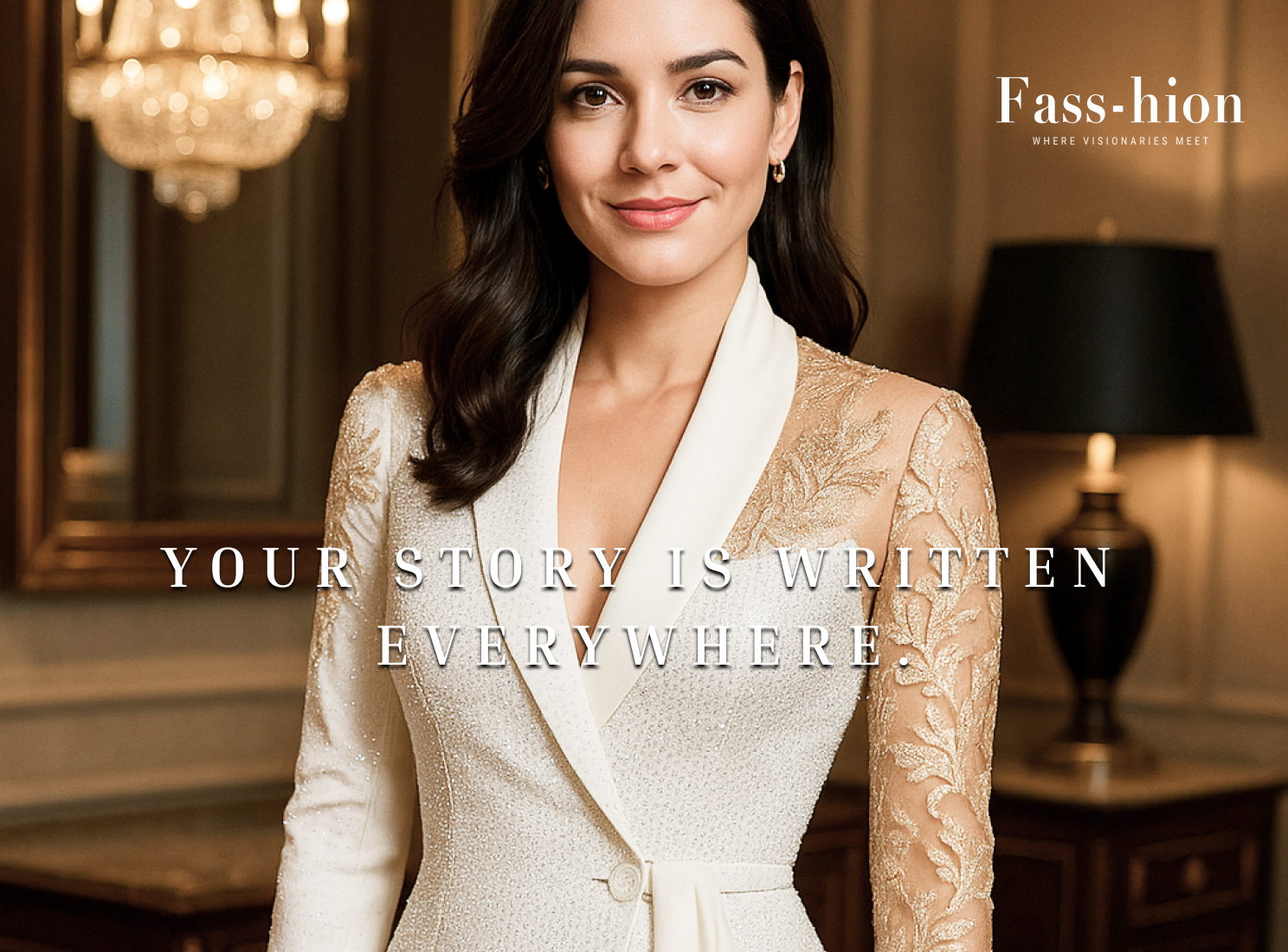Some stories you hear, while others you see. Some are whispered in boardroom corridors, some are sewn into silk blouses, and some, like Beatrice McLaren’s, are written everywhere: On billboards in New York. On the covers of fashion magazines such as “Fass-hion’, Vogue, Harper’s Bazaar and Porter. On the wrists of women wearing her jewellery. They are found in the quiet confidence of those who have learned from her example that grace and grit can coexist.
Beatrice McLaren, 42, wears pearls now. But she never forgets the hands that once trembled as they counted coins on a kitchen counter in a one-room apartment. She has jeans folded next to her designer skirts. She walks into board meetings in them sometimes, the denim dark and crisp, her pearls gleaming - a paradox of success that reminds everyone in the room: she’s come from the ground up, and she’s never left it.
Her name is more than just a brand; it’s a testament. Her empire didn’t begin in luxury showrooms or glossy magazine spreads; it started in silence, late nights, faith and the unglamorous middle ground where most stories end. But not hers. Beatrice learned early on that your story isn’t told when you make it to the top. It’s said by how you climb, and by how you continue to write when no one is watching.
The beginning: Denim and determination.
Before the pearls came the jeans. They were faded and torn, and they symbolised everything she didn’t have: wealth, access, and opportunity. Beatrice McLaren was raised in Glasgow by a single mother who worked two jobs and taught her that elegance wasn’t something you could buy, but something you could become. As a teenager, Beatrice had an instinct for style, but lacked the vocabulary to express it. She couldn’t afford to buy the clothes she loved, so she learned to make them herself. By the age of sixteen, she was repurposing vintage jackets from charity shops, stitching old blouses into skirts, and selling them to her classmates. By the age of twenty-one, she was sewing bespoke denim pieces in her mother’s kitchen and had named her line “McLaren Made”.
Her dream was simple: to design clothes for real women, women who worked, hustled, and hoped. She wanted to create a brand that felt attainable - but aspirational. But the world doesn’t open doors for every dream. For years, she faced rejection from investors who told her she lacked “pedigree,” fashion editors who dismissed her designs as “too simple,” and buyers who said “sophistication doesn’t sell in denim.”
But Beatrice had a rule: If they don’t see you, make them. So she kept showing up with a sewing kit in one hand and conviction in the other.

1. The Turning Point: From Local to Global.
Every empire begins with one courageous “yes.”
Hers came in 2009, when a celebrity stylist - caught in the rain during London Fashion Week - ducked into Beatrice’s tiny stall at a pop-up market in Shoreditch. She needed a change of outfit before the next show, and Beatrice offered her a pair of her signature jeans: structured yet soft, high-waisted, with pearl buttons stitched by hand. That stylist wore them to the Burberry show that night. By the weekend, the jeans were everywhere. Vogue UK called them “the modern woman’s armour.” Orders flooded in. The website crashed twice. Beatrice, still running her business from her living room, suddenly had a brand.
She renamed it “McLaren Atelier.”
Although her designs evolved, they remained rooted in the authenticity of denim. They also expanded to include ready-to-wear pieces that combined casual wear with couture. To symbolise her journey from simplicity to sophistication, she launched a “Pearl & Denim” collection. Each piece bore a small embroidered signature: B.M., her initials, representing her promise and boldness.
2. The Philosophy: Elegance Is Earned.
Beatrice McLaren is a woman who built a fashion empire by selling reality. She built it by selling the idea of reality.
Her campaigns were never about impossible beauty standards. They were about women in motion, entrepreneurs, artists, mothers, dreamers. She featured real women in her ads long before it was a trend. She spoke directly to the working woman who changed her shoes in the elevator and the visionary who wrote her dreams between deadlines.
“I didn’t want to design for the runway,” Beatrice once said in an interview with “Fass-hion Magazine”. “I wanted to design for the walkway - the path every woman takes to build her life.” Her business ethos reflected that same authenticity. She paid her seamstresses above market rates. She launched mentorship programs for young designers from underrepresented backgrounds. And when the pandemic hit, she shifted production to create sustainable loungewear made from recycled fibres - years before “eco-chic” became corporate language. She didn’t follow trends - she set standards.
3. The Struggle: When the Lights Went Out.
The story of Beatrice McLaren wasn’t always illuminated. Before the features, the fame, the Forbes list, there were shadows.
In 2012, her business nearly collapsed. A major supplier defaulted. Shipments were delayed. A retail partner pulled out. She was left with debt, doubt, and the sinking realisation that brilliance wasn’t bulletproof. She spent nights in the studio, alone, the hum of sewing machines her only comfort. She recalls, “I remember crying over fabric - literally over the fabric - because it was all I had left that felt alive.” But that moment became her awakening. She decided to rebuild, not just as a designer, but as a leader. She learned about supply chains, studied branding, negotiated deals herself, and rebuilt her label from the ground up. And this time, she added something new to her process: prayer.
Beatrice began to see her creativity as something divine, an echo of purpose. She said, “I realised fashion was my language of faith. Every design was a confession that beauty can rise from struggle.” That perspective became her trademark. And that faith-infused resilience would soon make her unstoppable.

4- The Rise: When the World Took Notice
By 2015, Beatrice McLaren’s name had become synonymous with “modern sophistication.” Her collections blended the structure of Paris couture with the soul of Scottish craftsmanship. The McLaren woman was confident, unpretentious, and powerful, like Beatrice herself.
She began appearing on panels for Forbes Women, Business of Fashion, Vogue Business, and Martin’s Business. Her designs were spotted on global icons. Amal Clooney, Meghan Markle, and Viola Davis. Harper’s Bazaar called her “the quiet storm of fashion.” Elle dubbed her “the woman who reinvented elegance.” Then came the cover that changed everything: Fass-hion Magazine, September 2020 issue. The headline read: “Beatrice McLaren: The Woman Who Wrote Her Story Everywhere.” In the interview, she said something that became a global mantra:
“Your story isn’t hidden - it’s just waiting to be seen. The world doesn’t write it for you. You do.”
The quote went viral. It appeared on posters, Pinterest boards, and LinkedIn posts by women across industries. Her words transcended fashion - they became a movement.
5. The Empire: What She Built.
Today, McLaren Atelier has a presence in over 50 countries. Its signature collections, the Pearl Line, the Denim Line and the Legacy Line, generate millions of pounds in revenue each year. Yet Beatrice remains grounded. She is known for walking into executive meetings wearing jeans and a white blouse with perfectly placed pearls and maintaining her humility.
When young designers ask her how she stayed true, she says, “I never changed to fit the room. I built the kind of room I could stay in.” Her company headquarters reflect that philosophy - an open-concept workspace filled with natural light, walls adorned with sketches from her early years, and a quote painted near the entrance: “Write your story, then wear it.” McLaren Atelier has also become a cultural hub. It funds scholarships for women in creative fields. It runs mentorship labs in Paris and Lagos. It champions ethical sourcing, hiring female artisans from developing regions. Beatrice often says, “If success doesn’t lift others, it’s not success - it’s vanity.”
Her personal brand is as strong as her business. She’s an investor, author, and motivational speaker. Her bestselling book, Threads of Grace, chronicles her journey and offers one guiding truth:
“You don’t need permission to begin. You need conviction to continue.”



Comments ()